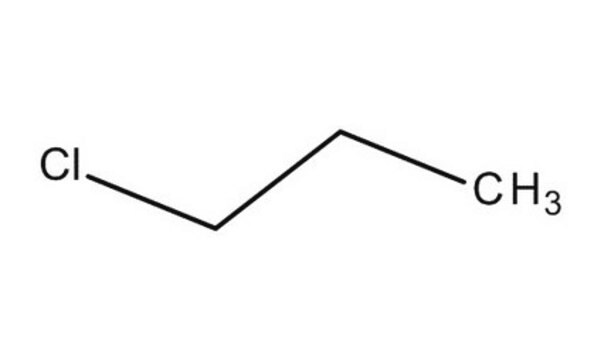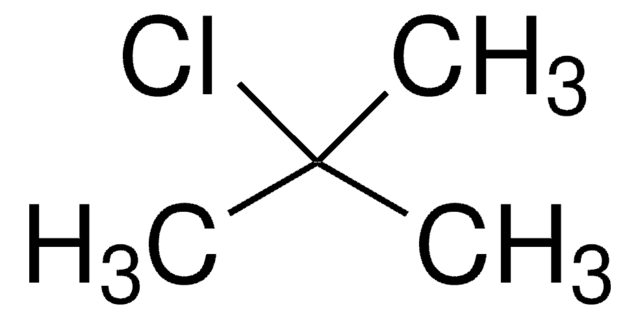About This Item
Recommended Products
vapor density
2.71 (vs air)
Quality Level
vapor pressure
5.51 psi ( 20 °C)
Assay
98%
form
liquid
autoignition temp.
968 °F
expl. lim.
11 %
refractive index
n20/D 1.388 (lit.)
bp
46-47 °C (lit.)
mp
−123 °C (lit.)
density
0.892 g/mL at 25 °C (lit.)
storage temp.
2-8°C
SMILES string
CCCCl
InChI
1S/C3H7Cl/c1-2-3-4/h2-3H2,1H3
InChI key
SNMVRZFUUCLYTO-UHFFFAOYSA-N
Looking for similar products? Visit Product Comparison Guide
Related Categories
Application
- Theoretical and experimental studies of the kinetics of the reaction of 1-chloropropane and fully deuterated 1-chloropropane with atomic chlorine: This study explores the reaction kinetics of 1-chloropropane with atomic chlorine, providing insights into the influence of carbon position in molecular interactions (L Fojcik et al., 2021).
- High-pressure phase equilibrium in the {carbon dioxide (1)+ 1-chloropropane (2)} binary system: Research determining the phase equilibrium properties of 1-chloropropane under various conditions, useful for industrial applications involving carbon dioxide and 1-chloropropane (M Chorazewski et al., 2015).
- Temperature dependent dielectric relaxation studies of halopropane from 10 Mhz to 50 Ghz using a time domain reflectometry (TDR): This study investigates the dielectric properties of 1-chloropropane across a broad frequency range, highlighting its applications in the pharmaceutical and pesticide industries (RV Shinde et al., 2020).
- A Study on Subchronic Inhalation Toxicity of 1-Chloropropane: An examination of the inhalation toxicity of 1-chloropropane, providing critical data for occupational safety and health assessments (Y Hyun Chung et al., 2015).
- Thermal decomposition of 1-chloropropane behind the reflected shock waves in the temperature range of 1015–1220 K: A comprehensive analysis of the decomposition mechanisms of 1-chloropropane under high-temperature conditions, significant for understanding thermal stability and reaction kinetics (G Sudhakar et al., 2014).
Signal Word
Danger
Hazard Statements
Precautionary Statements
Hazard Classifications
Acute Tox. 4 Dermal - Acute Tox. 4 Inhalation - Acute Tox. 4 Oral - Flam. Liq. 2
Storage Class Code
3 - Flammable liquids
WGK
WGK 3
Flash Point(F)
-0.4 °F - closed cup
Flash Point(C)
-18 °C - closed cup
Personal Protective Equipment
Regulatory Listings
Regulatory Listings are mainly provided for chemical products. Only limited information can be provided here for non-chemical products. No entry means none of the components are listed. It is the user’s obligation to ensure the safe and legal use of the product.
FSL
Group 4: Flammable liquids
Type 1 petroleums
Hazardous rank II
Water insoluble liquid
ISHL Indicated Name
Substances Subject to be Indicated Names
ISHL Notified Names
Substances Subject to be Notified Names
JAN Code
C68555-BULK:
C68555-VAR:
C68555-5G:
C68555-100ML:
C68555-500G:
C68555-500ML:
C68555-5ML:
C68555-100G:
Choose from one of the most recent versions:
Already Own This Product?
Find documentation for the products that you have recently purchased in the Document Library.
Customers Also Viewed
Our team of scientists has experience in all areas of research including Life Science, Material Science, Chemical Synthesis, Chromatography, Analytical and many others.
Contact Technical Service












